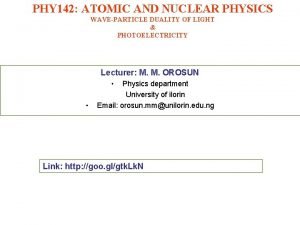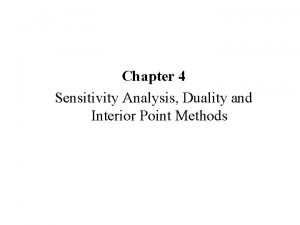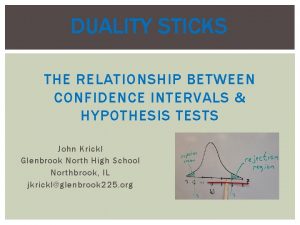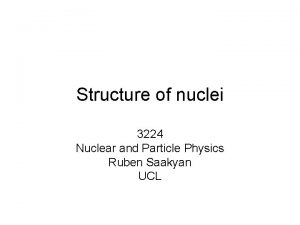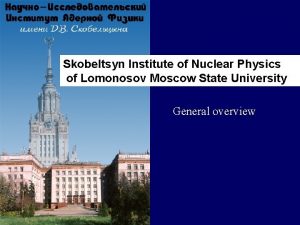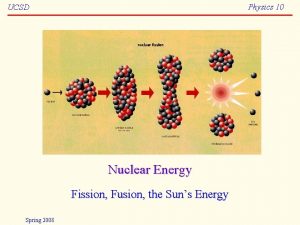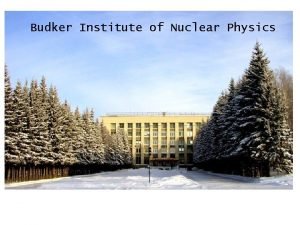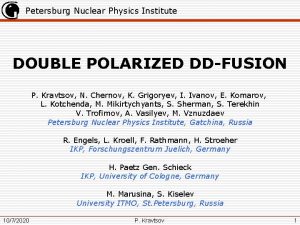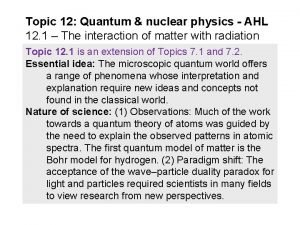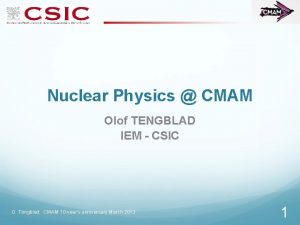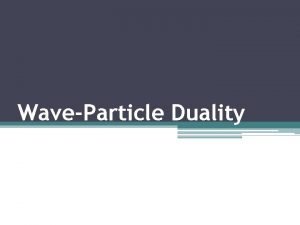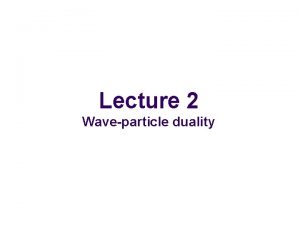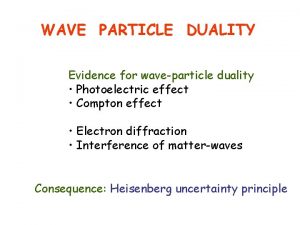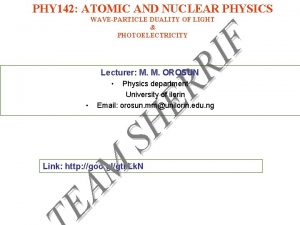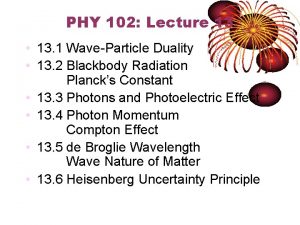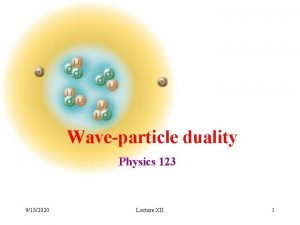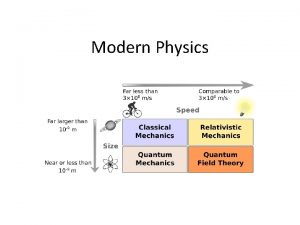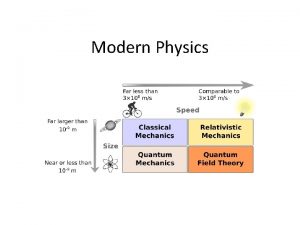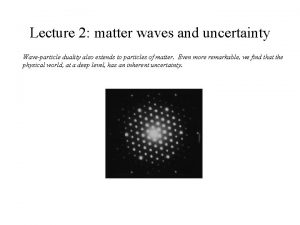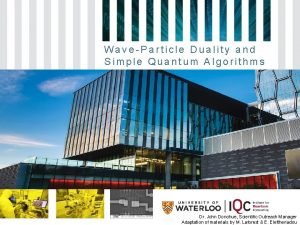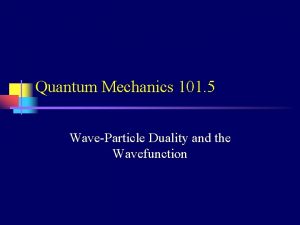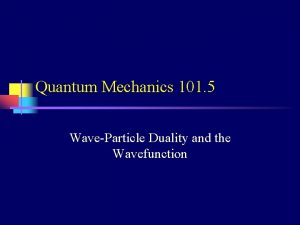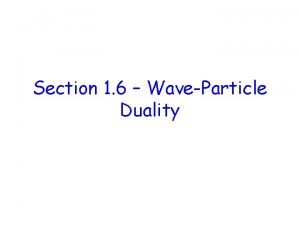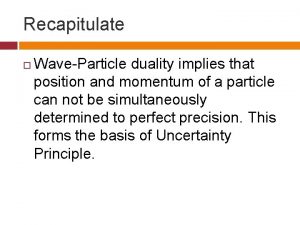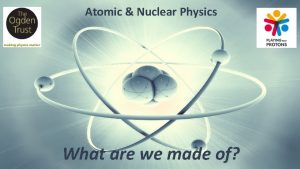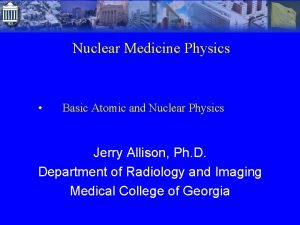PHY 142 ATOMIC AND NUCLEAR PHYSICS WAVEPARTICLE DUALITY






















- Slides: 22

PHY 142: ATOMIC AND NUCLEAR PHYSICS WAVE-PARTICLE DUALITY OF LIGHT & PHOTOELECTRICITY Lecturer: M. M. OROSUN • • Physics department University of ilorin Email: orosun. mm@unilorin. edu. ng Link: http: //goo. gl/gtk. Lk. N

WAVE-PARTICLE DUALITY OF LIGHT In 1924 Einstein wrote: - “ There are therefore now two theories of light, both indispensable, and … without any logical connection. ” Evidence for wave-nature of light • Diffraction and interference Evidence for particle-nature of light • Photoelectric effect • Compton effect • Light exhibits diffraction and interference phenomena that are only explicable in terms of wave properties • Light is always detected as packets (photons); if we look, we never observe half a photon • Number of photons proportional to energy density (i. e. to square of electromagnetic field strength) Consequence: Heisenberg uncertainty principle

De Broglie MATTER WAVES We have seen that light comes in discrete units (photons) with particle properties (energy and momentum) that are related to the wave-like properties of frequency and wavelength. In 1923 Prince Louis de Broglie postulated that ordinary matter can have wave-like properties, with the wavelength λ related to momentum p in the same way as for light de Broglie relation Planck’s constant de Broglie wavelength NB wavelength depends on momentum, not on the physical size of the particle Prediction: We should see diffraction and interference of matter waves

PHOTOELECTRIC EFFECT Hertz J. J. Thomson When UV light is shone on a metal plate in a vacuum, it emits charged particles (Hertz 1887), which were later shown to be electrons by J. J. Thomson (1899). Light, frequency ν Vacuum chamber Collecting plate Metal plate I Ammeter Potentiostat Classical expectations Electric field E of light exerts force F=e. E on electrons. As intensity of light increases, force increases, so KE of ejected electrons should increase. Electrons should be emitted whatever the frequency ν of the light, so long as E is sufficiently large For very low intensities, expect a time lag between light exposure and emission, while electrons absorb enough energy to escape from material

PHOTOELECTRIC EFFECT (cont) Actual results: Maximum KE of ejected electrons is independent of intensity, but dependent on ν For ν<ν 0 (i. e. for frequencies below a cut-off frequency) no electrons are emitted There is no time lag. However, rate of ejection of electrons depends on light intensity. Einstein’s interpretation (1905): Light comes in packets of energy (photons) Millikan An electron absorbs a single photon to leave the material The maximum KE of an emitted electron is then Planck constant: universal constant of nature Work function: minimum energy needed for electron to escape from metal (depends on material, but usually 2 -5 e. V) Verified in detail through subsequent experiments by Millikan

COMPTON SCATTERING Compton (1923) measured intensity of scattered X-rays from solid target, as function of wavelength for different angles. He won the 1927 Nobel prize. X-ray source Collimator (selects angle) Crystal (selects wavelength) θ Target Result: peak in scattered radiation shifts to longer wavelength than source. Amount depends on θ (but not on the target material). Detector A. H. Compton, Phys. Rev. 22 409 (1923)

COMPTON SCATTERING (cont) Classical picture: oscillating electromagnetic field causes oscillations in positions of charged particles, which re-radiate in all directions at same frequency and wavelength as incident radiation. Change in wavelength of scattered light is completely unexpected classically Incident light wave Oscillating electron Emitted light wave Compton’s explanation: “billiard ball” collisions between particles of light (X-ray photons) and electrons in the material Before After scattered photon Incoming photon θ Electron scattered electron

COMPTON SCATTERING (cont) Before After Incoming photon Electron Conservation of energy scattered photon θ scattered electron Conservation of momentum From this Compton derived the change in wavelength

SUMMARY OF PHOTON PROPERTIES Relation between particle and wave properties of light Energy and frequency Also have relation between momentum and wavelength Relativistic formula relating energy and momentum and For light Also commonly write these as angular frequency wavevector hbar

Let us Estimate some de Broglie wavelengths • Wavelength of electron with 50 e. V kinetic energy • Wavelength of Nitrogen molecule at room temperature • Wavelength of Rubidium(87) atom at 50 n. K

HEISENBERG MICROSCOPE AND THE UNCERTAINTY PRINCIPLE (also called the Bohr microscope, but the thought experiment is mainly due to Heisenberg). The microscope is an imaginary device to measure the position (y) and momentum (p) of a particle. Heisenberg Particle θ/2 Light source, wavelength λ Lens, with angular diameter θ Resolving power of lens:

HEISENBERG MICROSCOPE (cont) Photons transfer momentum to the particle when they scatter. Magnitude of p is the same before and after the collision. Why? p Uncertainty in photon y-momentum = Uncertainty in particle y-momentum p Small angle approximation de Broglie relation gives From before θ/2 and so hence HEISENBERG UNCERTAINTY PRINCIPLE.

HEISENBERG UNCERTAINTY PRINCIPLE It follows that; HEISENBERG UNCERTAINTY PRINCIPLE. We cannot have simultaneous knowledge of ‘conjugate’ variables such as position and momenta. Note, however, etc Arbitary precision is possible in principle for position in one direction and momentum in another

HEISENBERG UNCERTAINTY PRINCIPLE There is also an energy-time uncertainty relation Transitions between energy levels of atoms are not perfectly sharp in frequency. n = 3 n = 2 n = 1 An electron in n = 3 will spontaneously decay to a lower level after a lifetime of order

CONCLUSIONS Light and matter exhibit wave-particle duality Relation between wave and particle properties given by the de Broglie relations , Evidence for particle properties of light Photoelectric effect, Compton scattering Evidence for wave properties of matter Electron diffraction, interference of matter waves (electrons, neutrons, He atoms, C 60 molecules) Heisenberg uncertainty principle limits simultaneous knowledge of conjugate variables

PHOTOELECTRICITY When light falls on metal surfaces, electrons are emitted. This is the photo-electric effect. The emitted electrons are known as photo-electrons i. e. when light (e. g ultraviolent rays) fall on zinc plate, electrons are liberated from zinc plates. This phenomenon is called photoelectric emission. In general, the emission of electrons as a result of electromagnetic wave falling on the matter is referred to as photoelectric effect. Photo-electric emission occurs when electrons are emitted from surface of metal plates when it is illuminated by light of sufficient high frequency.

. The following important observations were made in the study of the photoelectric effect. Electrons are emitted at the instant the surface is illuminated even with light of very weak intensity: • For each metal there is a well defined frequency called the Threshold Frequency which must be exceeded for electrons emission to occur, no matter how strong the intensity of light may be. • The maximum kinetic energy of the emitted electrons increases with the frequency of the incident light but is independent of the intensity of light. • This follows that, emission of electrons depends on the threshold frequency, but rate of emission of electrons depends on the intensity of the light. • Threshold Frequency: is the minimum frequency of the illuminating light which will just be sufficient to cause photoelectric emission. The threshold frequency is not the same for all metals, the energy of the emitted electrons varies from zero to a maximum.

PHOTOELECTRIC CELL AND ITS MODE OF OPERATION • • • When light photons incident or fall on the cathode (i. e. emission metal plate) electrons are emitted which goes to the anode or collector to generate current flow. • When intensity of light varies, the rate of emission of electrons varies, thus, the flow of current varies. • Explanation of what happens to energy of light before emission of electrons begins. • The energy of illuminating light as absorbed by photo-cell and are used to overcome the force that bind the electron together, but this may not be sufficient to remove the electron until light with sufficient threshold frequency is attained. One factor that may affect the number of emitted electron is the intensity of the light.

Work Function The minimum energy tom liberate an electron from the surface of a metal is called work function of that metal or Binding Energy. Work function = hfo, where fo is the threshold frequency and h = Planck’s constant. Energy of the illuminating light = hf; where f = frequency of the light. • Part of this energy is also to overcome the work function of the metal (i. e. to get the electron free from the atom and away from the metal surface). The reminder of the energy is used to give the liberated electron a kinetic energy, (Ek = ½mv 2) where v is the velocity of the photoelectron of mass M. the work function, w = hfo • Energy of the illuminating light = Work Function + Kinetic Energy of Electrons • Maximum Kinetic Energy a photoelectron can posses = Energy of the illuminating light – Work Function • Ek = [hf – hfo]; --------------------------------------------(i) • where. Ek = ½mv 2; This is Einstein’s Photoelectric Equation. • Note that, the energy of the ejected electron may be found by determining what potential different (v) must be applied to stop its motion. • Then, Ek = ½mv 2 = e. Vs--------------------------------------(ii) • The product e. V is the electron-volt and Vs is the stopping potential. Stopping Potential (Vs) is point attain for which no electrons reach the collector (Anode). • Ek = e. V = hf – hfo------------------------------------------(iii) Note also that, Number of electrons hitting the anode per second = current divided by electron charge. • • i. e. No. of Electrons striking the target per second = = also, the Electric Power Input, P = Current x Voltage = IV


• • Calculate the wavelength associated with the following objects Electron moving with velocity of m/s Bullet of mass 0. 01 kg with velocity 400 ms-1 Sprinter of mass 60 kg with velocity 10 m/s • • Electrons are accelerated by a P. D 100 v 400 v Calculate the wavelength associated with the electrons on each case. • An x- ray photon has a wavelength of 3. 3×m. Calculate the momenturn, mass and energy of the particle associated with the photon, which moves with a velocity c. Electrons are accelerated from rest through a potential difference of 10, 000 v in an X-ray tube. Calc. » The resultant energy of the electrons in e. V » The wavelength of the associated electron waves » The maximum energy and the minimum wavelength of the x- ray generated. ( charge of the electron = 1. 6 ×c , mass of the electron = 9. 11 ×kg, h= 6. 62 ×JS) • • •

• Calculate de- Broglie wavelength associated with a proton moving with a velocity equal to 1/20 th of the velocity of light. Ans = 2. 64 × 10 -14 m • Find the energy of the neutron in units of electron volt whose de- Broglie wavelength 1 Ao. Given mass of neutron=1. 67 × 10 -27 kg , h = 6. 6 × 10 -34 JS, 1 Ao = 10 -10 m ANS= E= 8. 13 × 10 -2 e. V • Compute the de-Broglie wavelength of 10 Ke. V neutron. Mass of neutron may be taken as 1. 675 × 10 -27 kg. ANS = 2. 86× 10 -13 m • What is de- Broglie wavelength of an electron which has been accelerated from rest through a potential difference of 100 V? ANS=λ=1. 225Ǻ= 1. 225× 10 -10 m. • Compute the de-Broglie wavelength of a proton whose kinetic energy is equal to the rest energy of an electron. Mass of a photon is 1836 times that of the electron. ANS= 0. 0004Ǻ=4× 10 -4Ǻ= 4 × 10 -14 m. • Energy of a particle at absolute temperature T is the order KT. Calculate the wavelength of thermal neutrons at 27 oc, gives mass of the neutron= 1. 67× 10 -27 kg , h= 6. 6 × 10 -34 Js , Bolts- Mann’s constant k = 8. 6 × 10 -5 e. Vdeg-1 = 8. 6× 10 -5 × 1. 6 × 10 -19 = 1. 376 × 10 -23 Jdeg-1 , T= 27 oc=300 ok.
 Physics 142
Physics 142 Lesson 15 nuclear quest nuclear reactions
Lesson 15 nuclear quest nuclear reactions Fisión nuclear vs fision nuclear
Fisión nuclear vs fision nuclear Relative atomic mass of beryllium
Relative atomic mass of beryllium How to calculate abundance of isotopes
How to calculate abundance of isotopes Atomic mass and atomic number difference
Atomic mass and atomic number difference Quantum and nuclear physics
Quantum and nuclear physics Atomic radius and ionization energy
Atomic radius and ionization energy Radius trend periodic table
Radius trend periodic table Atomic number vs atomic radius
Atomic number vs atomic radius Phy113
Phy113 Discreteness and duality
Discreteness and duality Sensitivity analysis and duality
Sensitivity analysis and duality Duality of confidence interval and hypothesis test
Duality of confidence interval and hypothesis test Strange case of jekyll and hyde setting
Strange case of jekyll and hyde setting Magic nuclei
Magic nuclei Skobeltsyn institute of nuclear physics
Skobeltsyn institute of nuclear physics Nuclear fission
Nuclear fission Scattering cross section in nuclear physics
Scattering cross section in nuclear physics Budker institute of nuclear physics
Budker institute of nuclear physics Petersburg nuclear physics institute
Petersburg nuclear physics institute Physics topic 12
Physics topic 12 Nuclear physics
Nuclear physics
